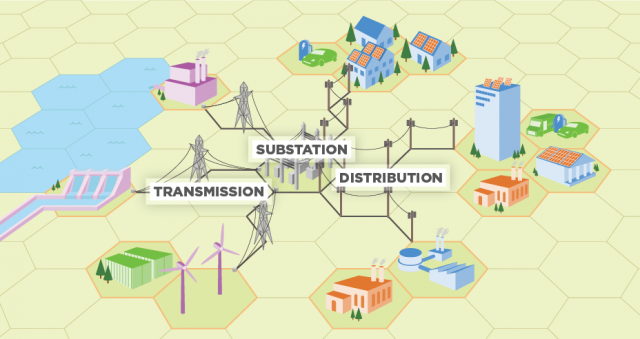Centralized Generation of Electricity and its Impacts on the Environment

- About centralized generation
- Centralized generation in the United States
- Environmental impacts of centralized generation
About Centralized Generation
“Centralized generation” refers to the large-scale generation of electricity at centralized facilities. These facilities are usually located away from end-users and connected to a network of high-voltage transmission lines. The electricity generated by centralized generation is distributed through the electric power grid to multiple end-users. Centralized generation facilities include fossil-fuel-fired power plants, nuclear power plants, hydroelectric dams, wind farms, and more.
Centralized Generation in the United States
The vast majority of the electricity that Americans use is from centralized generation. Centralized generation facilities in the United States currently have the capacity to generate more than 1,100 gigawatts of electric power.
The earliest electric utilities operated independently from each other. A consumer would purchase electricity from a utility in their area, which would then provide the electricity through its own electricity delivery system. During the second half of the 20th century, utilities found it more efficient and economical to connect their delivery systems, resulting in the need to coordinate power plant operations. The majority of electricity generation in the United States today is coordinated by regional system operators to ensure reliability. Therefore, the electricity delivered to consumers by their local electric utility may be generated at a centralized power plant located in another city or state and owned by a different company. These power plants are subject to economic, reliability, and environmental regulations by federal, tribal, state, and/or local governments.
Environmental Impacts of Centralized Generation
The environmental impacts of electricity generation can contribute to large-scale regional environmental concerns as well as localized concerns that affect the area directly surrounding a power plant. Some impacts vary based on the energy resource—for example, whether the power plant uses fossil fuel or a renewable resource. In addition to the impacts from power generation, there are also impacts associated with extracting, producing, and transporting certain fuels such as coal and natural gas.
In general, centralized power plants can affect the environment in the following ways:
- Air pollutant emissions:
- The amount and type of emissions will vary by fuel burned and other plant characteristics.
- Air pollution from burning fuel often includes carbon dioxide, sulfur dioxide, nitrogen oxides, mercury, and particulate matter.
- Water use and discharge:
- Water used for steam production or cooling may be returned at warmer temperatures to water bodies and may contain contaminants.
- Some water may also be lost to evaporation.
- Waste generation:
- Burning certain fuels results in solid waste such as ash, which must be stored and eventually disposed of properly.
- Some wastes contain hazardous substances. For example, nuclear power generation produces radioactive waste, while coal ash can contain heavy metals like mercury.
- Land use:
- Large power plants require space for their operations.
- Centralized generation requires transmission lines, which also use land.
In addition to these environmental impacts, much of the primary energy (total energy content) of fossil fuels burned at power plants is wasted during generation and delivery to end-users. Opportunities exist to improve the energy efficiency of power plants, as well as to locate electricity generation closer to end-users to reduce losses during electricity delivery.
